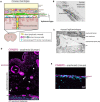Living on the Edge of the CNS: Meninges Cell Diversity in Health and Disease
- PMID: 34276313
- PMCID: PMC8281977
- DOI: 10.3389/fncel.2021.703944
Living on the Edge of the CNS: Meninges Cell Diversity in Health and Disease
Erratum in
-
Corrigendum: Living on the Edge of the CNS: Meninges Cell Diversity in Health and Disease.Front Cell Neurosci. 2021 Oct 8;15:761506. doi: 10.3389/fncel.2021.761506. eCollection 2021. Front Cell Neurosci. 2021. PMID: 34690706 Free PMC article.
Abstract
The meninges are the fibrous covering of the central nervous system (CNS) which contain vastly heterogeneous cell types within its three layers (dura, arachnoid, and pia). The dural compartment of the meninges, closest to the skull, is predominantly composed of fibroblasts, but also includes fenestrated blood vasculature, an elaborate lymphatic system, as well as immune cells which are distinct from the CNS. Segregating the outer and inner meningeal compartments is the epithelial-like arachnoid barrier cells, connected by tight and adherens junctions, which regulate the movement of pathogens, molecules, and cells into and out of the cerebral spinal fluid (CSF) and brain parenchyma. Most proximate to the brain is the collagen and basement membrane-rich pia matter that abuts the glial limitans and has recently be shown to have regional heterogeneity within the developing mouse brain. While the meninges were historically seen as a purely structural support for the CNS and protection from trauma, the emerging view of the meninges is as an essential interface between the CNS and the periphery, critical to brain development, required for brain homeostasis, and involved in a variety of diseases. In this review, we will summarize what is known regarding the development, specification, and maturation of the meninges during homeostatic conditions and discuss the rapidly emerging evidence that specific meningeal cell compartments play differential and important roles in the pathophysiology of a myriad of diseases including: multiple sclerosis, dementia, stroke, viral/bacterial meningitis, traumatic brain injury, and cancer. We will conclude with a list of major questions and mechanisms that remain unknown, the study of which represent new, future directions for the field of meninges biology.
Keywords: arachnoid barrier; blood-CSF barrier; border-associated macrophages; fibroblast; meningeal lymphatic system; meninges.
Copyright © 2021 Derk, Jones, Como, Pawlikowski and Siegenthaler.
Conflict of interest statement
The authors declare that the research was conducted in the absence of any commercial or financial relationships that could be construed as a potential conflict of interest.
Figures



References
Publication types
Grants and funding
LinkOut - more resources
Full Text Sources

